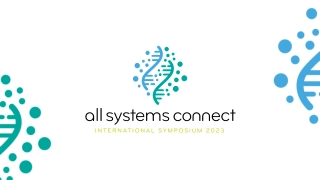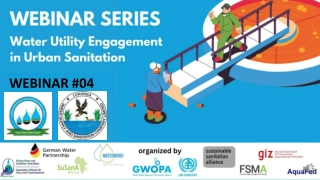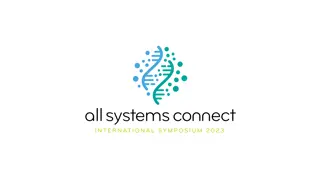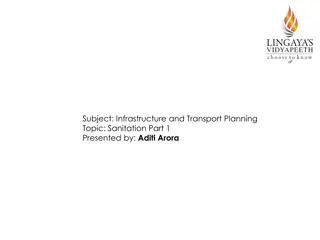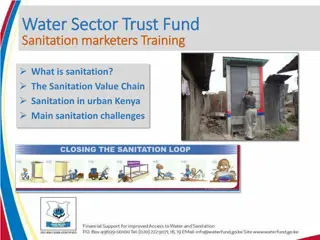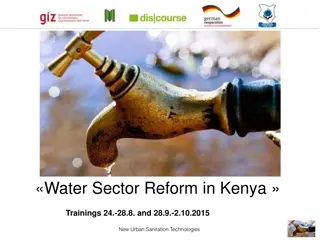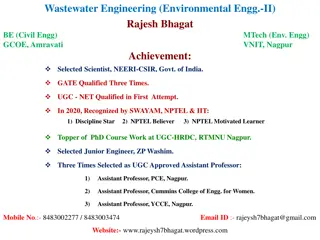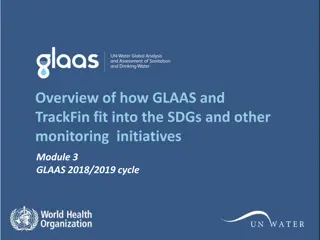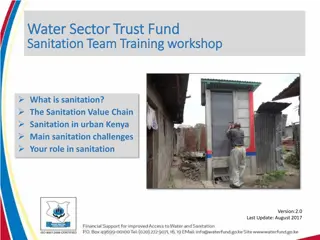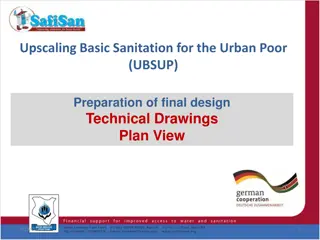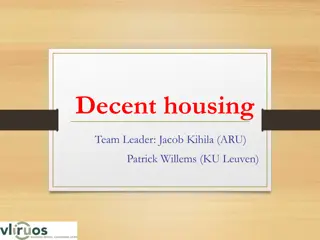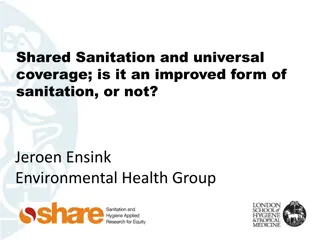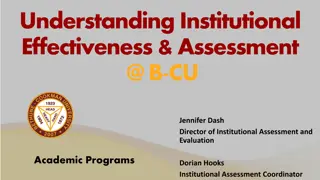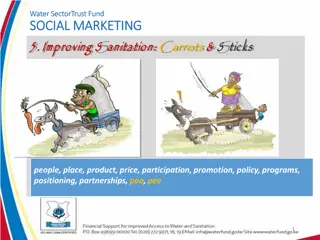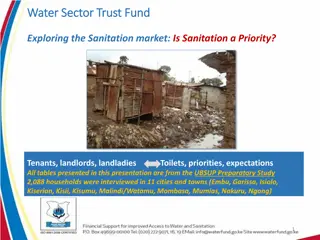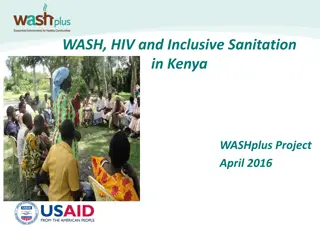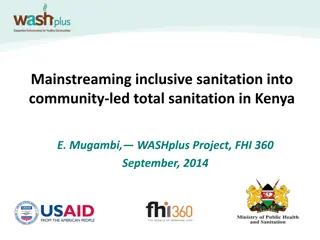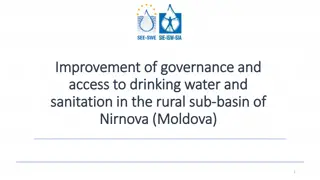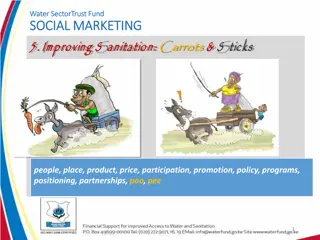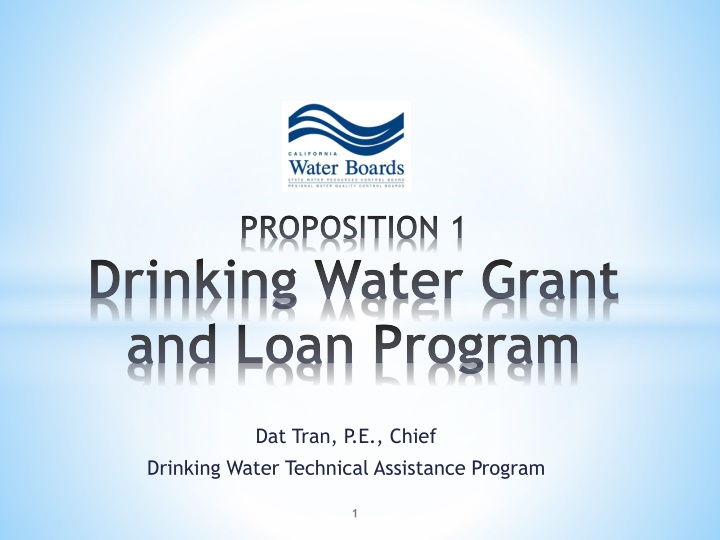
Institutional Arrangements in Sanitation Management
Sanitation management involves complex engineering infrastructure such as excreta, wastewater, solid waste, and drainage systems. Urban Local Bodies (ULBs) play a crucial role in ensuring efficient, affordable, and sustainable waste water services, including by-laws, development plans, and service provision mechanisms. Case studies of Delhi's MCD and NDMC highlight the challenges and practices in waste water treatment and disposal.
Download Presentation

Please find below an Image/Link to download the presentation.
The content on the website is provided AS IS for your information and personal use only. It may not be sold, licensed, or shared on other websites without obtaining consent from the author. If you encounter any issues during the download, it is possible that the publisher has removed the file from their server.
You are allowed to download the files provided on this website for personal or commercial use, subject to the condition that they are used lawfully. All files are the property of their respective owners.
The content on the website is provided AS IS for your information and personal use only. It may not be sold, licensed, or shared on other websites without obtaining consent from the author.
E N D
Presentation Transcript
PROPOSITION 1 Drinking Water Grant and Loan Program Dat Tran, P.E., Chief Drinking Water Technical Assistance Program 1
*Obtain public input on Drinking Water Program *Provide information on Program Meeting Purpose 2 of 17
*Application Process *Eligible Projects *Eligible Applicants *Funding Limits Set by Chapter 5 *Proposed Grant Allocation *Loans *Prioritization of Projects *Next Steps Topics of Discussion 3 of 17
*DWSRF Application *Applications submitted via Financial Assistance Application and Submittal Tool (FAAST) *All DWSRF requirements apply Application Process 4 of 17
*Public water system infrastructure improvements and related actions to meet safe drinking water standards *Planning Projects Eligible Projects 5 of 17
*Public Agencies *Non-profit organizations *Public utilities *Federally recognized Indian tribes *State Indian tribes *Mutual water companies Eligible Applicants 6 of 17
*$260 million allocated for Program *Up to $5 million grant per project *Up to $20 million grant per project that provides regional benefits, at least one shall be small disadvantaged community Funding Limits 7 of 17
*Grant amounts based on Table 1 (See next slide) *100% Grant for SDAC, schools, and economically distressed areas *$25,000 per service connection maximum or Board Approval *50,000 per service connection maximum for regional projects Grant Allocation 8 of 17
Table 1 Proposed Local Cost Share Requirements Affordability Criteria Grant Amount Approximate Monthly Water Bill Based on 2015 State MHI Data4 Water Rate as Percent of MHI1 Percentage of Total Project Cost2 Maximum Grant Amount ($ million)3 Loan or Raise Rates to 1.5% WMHI < 1.5% 65% 70% 80% 5 5 5 $61 $81 $102 1.5 WMHI < 2 DAC 2 WMHI < 2.5 WMHI 2.5% SDAC NA 100% 5 NA 1Public Schools for which water rates are not charged, the Division may approve 100% grant up to a maximum of $5 million. Economically distressed areas as defined by Chapter 2, Section 79702 (K) may receive 100% grant. 2Remainder of Project Cost will can be a Drinking Water Loan or other non-state water board grant. 3A maximum grant amount of $5 million per project, or $20 million per regional project where at least one entity is a DAC. 4These approximations were based on 2015 MHI amounts of $48,875 to qualify as a DAC and $36,656 to qualify as a SDAC. Applicants will use the MHI for their service area to calculate % of water rate to MHI. 9 of 17
*Extremely low interest loans available *Interest rate at GO Bond Rate (2015 Interest rate is 1.663%) *Maximum 30 year term Loans 10 of 17
*Small Community Water System in DAC *Shared solutions for multiple communities *DWSRF Categories *Readiness to proceed Prioritization of Projects 11 of 17
ABC Water Companys service area has 150 service connections, a MHI of $48,000 and water rates of $81 per month. The proposed project cost is $6 million. How much grant are they eligible for? Step 1: Are they a DAC? MHI is less than $48,875 so yes they are a DAC. Step 2: Are they a SDAC? MHI is more than $36,656 so they are not a SDAC. Example 12 of 17
ABC Water Companys service area has 150 service connections, a MHI of $48,000 and water rates of $81 per month. The proposed project cost is $6 million. How much grant are they eligible for? Step 3- What is the water rate as a percentage of MHI? = Monthly Water Bill X 12 = $81 per month X 12 Service Area MHI $48,000 = 0.02025 X 100 = 2.025% Example Continued 13 of 17
ABC Water Companys service area has 150 service connections, a MHI of $48,000 and water rates of $81 per month. The proposed project cost is $6 million. How much grant are they eligible for? Step 4 Go to Chart Affordability Criteria Grant Amount Approximat e Monthly Water Bill Based on 2015 State MHI Data4 DAC, Water Rate is 2.025% of MHI is eligible for Up to 70% grant, not to exceed $25,000 per connection Maximum Grant Amount ($ million)3 Water Rate as Percent of MHI1 WMHI < 1.5% Percentage of Total Project Cost2 Loan or Raise Rates to 1.5% 65% 70% 80% 5 5 5 $61 $81 $102 1.5 WMHI < 2 DAC 2 WMHI < 2.5 WMHI 2.5% =0.70 X $6 million = $4,200,000 SDAC NA 100% 5 NA 1Public Schools for which water rates are not charged, the Division may approve 100% grant up to a maximum of $5 million. Step 5- Check against connection cap = $25,000 X 150 connections = $3,750,000 2Remainder of Project Cost will can be a Drinking Water Loan or other non-state water board grant. 3A maximum grant amount of $5 million per project, or $20 million per regional project where at least one entity is a DAC. 4These approximations were based on 2015 MHI amounts of $48,875 to qualify as a DAC and $36,656 to qualify as a SDAC. Applicants will use the MHI for their service area to calculate % of water rate to MHI. Example Continued Project is eligible for $3.75 million grant and $2.25 million in loan 14 of 17
*Local Cost Share Requirements - What do you think about percentages presented in Table 1? - 100% grant for SDACs, schools and economically distressed areas? - Other comments or questions? *Per service connection caps $25,000 and $50,000 for regional projects - What do you think of limits? - Should the caps be higher or lower? - Other comments or questions? *Regional projects - Should regional project involve 3 or more water systems? Discussion Topics 15 of 17
*Take Feedback and Insert Requirements into IUP- April 2015 *Draft IUP Posted on Website May 2015 *Public Meetings June 2015 *Final IUP Adopted August 2015 *Application Solicitation - Ongoing Next Steps 16 of 17
For more information please contact: Brian Kinney, P.E. (916) 449-5630 Brian.kinney@waterboards.ca.gov Jennifer Toney, P.E. (916) 341-5646 Jennifer.toney@waterboards.ca.gov Dat Tran, P.E. (916) 248-2719 Dat.Tran@waterboards.ca.gov Contact Information 17 of 17

